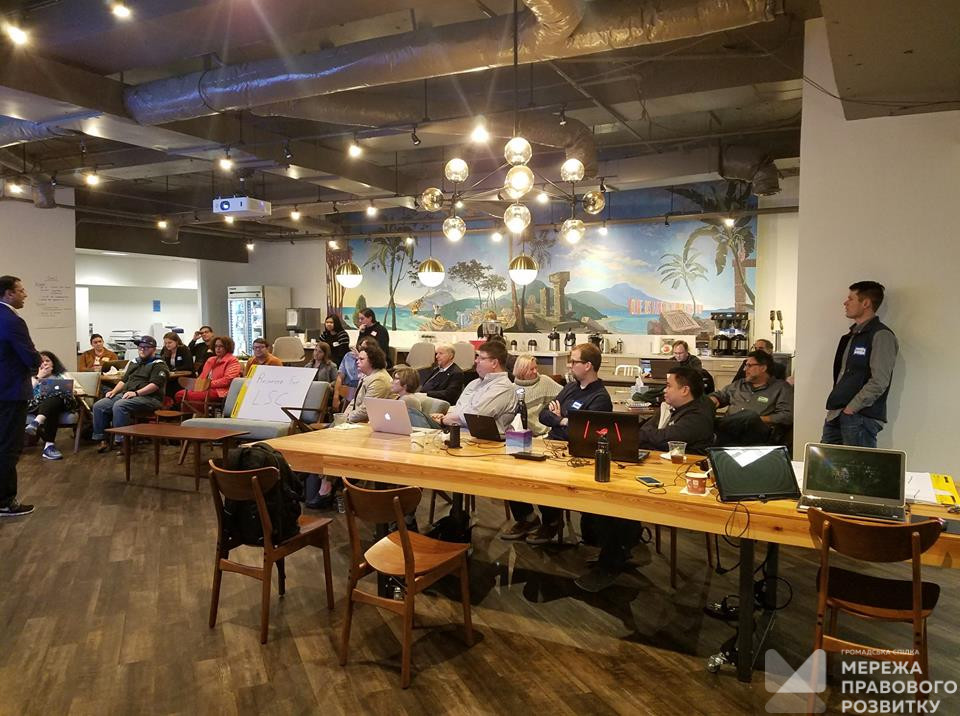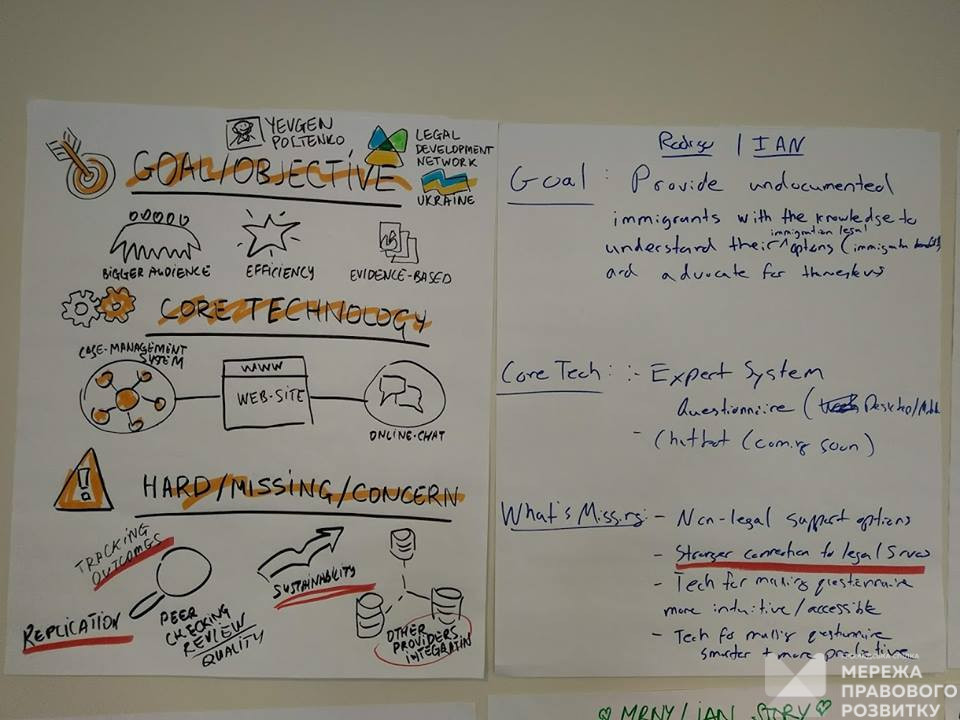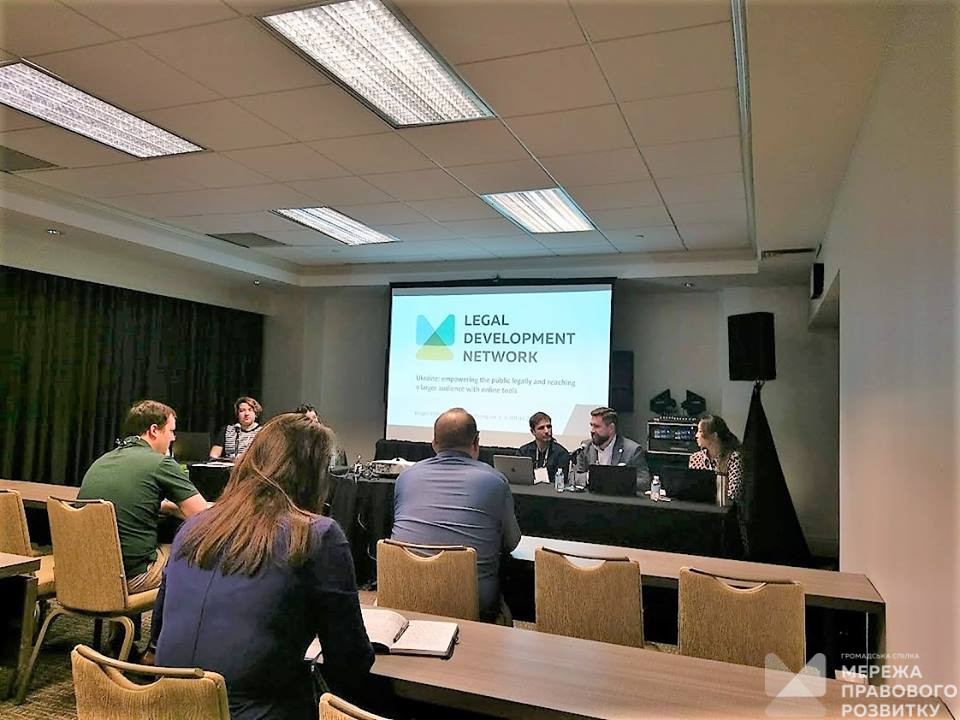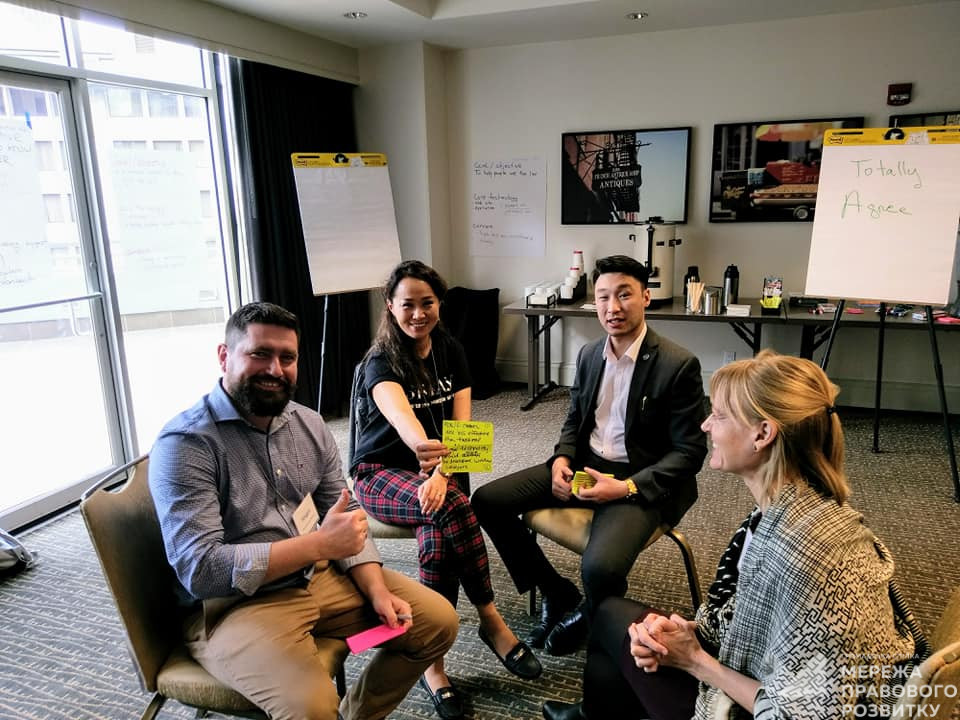Technological opportunities to expand access to justice
Publication date: January 29, 2019
Technology innovation Conference #LSCITCon in early January 2019 gathered in New Orleans (USA) a wide range of practices for demonstrating technological projects and tools that are being implemented to promote access to justice and provide high-quality legal services to low-income people.
This material is based on the results of the conference, and on the impression from the study “Technologies for management. The Global Review “(The Engine Room (2019). Technology for Legal Empowerment: A Global Review).
The participation of representatives of the Legal Development Network in the conference thanks to support of the International Renaissance Foundation.

Legal empowerment, or improving legal opportunities, directly relates to improving people’s capabilities to exercise their rights. This is a basic level of justice – when the law is not restricted to codes and halls of courts of justice, but it is accessible and useful to all people.
People and organizations, including Legal Development Network, work to achieve this goal around the world, applying a variety of approaches: from providing free legal services to ensuring accessible legal education and information. All those approaches imply explaining people how the law impact them in their everyday lives, improving their ability to use formal justice systems, and also enabling people to influence the improvement of legislation.

One of the ways to achieve this goal is applying technology to provide information about the law, providing them with technological opportunities for obtaining legal advice and services. Technologies for legal empowering vary according to jurisdiction, justice system, systems of providing legal aid.
How citizens interact with law and legal services
A wide range of technologies is aimed at citizens – from SMS-based information systems to web-sites that allow people to create legal documents, resolve disputes, and find legal information that is relevant to their particular situation. What does technology really add (or does not add) to existing trust building tools? What makes technology projects more manageable and useful for people?
There are many gaps in our knowledge of how citizens interact with law and legal services. Recent studies, including those conducted in Ukraine, have expanded our understanding of how people solve legal problems.
Studies on legal capacities show that, despite the fact that many people are faced with legal problems, they often do not know that their problem is legal in nature and they do not know which legal support may be available to them. Often, they do not try to solve the problem at all. Those who make such attempts are unlikely to turn to lawyers or courts, and they hope for help from relatives or acquaintances. In many countries, informal justice systems also provide an affordable alternative to formal mechanisms, providing quick, relatively inexpensive assistance conforming with local traditions.

Technological solutions are more effective means of providing legal services to a wider range of people. In particular, technologies increase the potential for expanding geographical coverage of legal aid; allow people to help themselves more effectively; reduce the cost of involving professional lawyers. Legal information, presented through readily accessible channels and in a more understandable way, also has the potential to reduce inequality in access to justice.
Throughout the world, legal initiatives already use technology for:
- helping people to diagnose their legal problems independently;
- helping people determine whether they have the right to free legal aid,
- providing people with legal information in a clear and easily accessible form,
- providing people with legal information that is tailored according to their specific situations, needs,
- supportingpeople for self-representation in court or for out-of-court dispute resolution,
- automatic formingof legal documents;
- transferringpeople to organizations that can help them.
The most commonly technologies used in legal empowerment, along with examples interaction of users and legal aid providers:
- Static Sites: Resources that provide legal information to unauthorized persons in a static (unchanged, user-friendly) form (www.firedwithoutcause.com, singaporelegaladvice.com/law-articles/how-do-imake-a-will/, higrit.com , https://yavo.md)
- Routers (guides) for legal information: they ask users a number of questions that help clarify, identify, or select the legal problem they are facing, and then provide users with information that meets their needs (www.ldn.org.ua, www.confidentcommuter.org.au, www.illinoislegalaid.org)
- Routers (guides) to specialized legal advisers: they offer users to identify their problem before providing them with information about organizations or individuals such as pro bono lawyers who can provide further support (https://pakistanlawyer.com/, www. citizenshipworks.org, https://justiceconnect.org.au/)
- On-line chats: they allow users to ask questions directly to a legal adviser who responds in real time (https://ldn.org.ua/section/legal-help/, www.citizensadvice.org.uk, www .lawhelpny.org)
- Automatic designers of legal documents: these services allow the user to create the required documents (https://axdraft.com/, www.a2jauthor.org, http://www.c-app.org.uk/)
- Online dispute resolution (ODR): these tools provide an on-line interface facilitating the resolution of disputes (usually in consumer or civil law matters such as divorce), they can support negotiations and mediation, or a combination of them (http://www.e-court.nl/, www.presolv360.com, https://mylawbc.com/tools/)
- Structured data collection: these initiatives help users to collect case data in a structured way that they can use as evidence in the justice system (https://heatseek.org/, www.callistocampus.org)
- Bots: they provide information in the interface of different messengers through messaging, which is an automated thread of questions and answers, the content of which is determined by conditional logic (https://itunes.apple.com/app/id1427999657, http://robotlawyerlisa. com/, http://try.lawpath.com.au/privacy-bot)
The five main types of technologies are used to allow people to perform these interactions:
- web-sites
- SMS and USSD messages
- applications for mobile phones (applications);
- online chat services (on websites),
- chat bots (provided through messaging programs, messengers).
Most initiatives use websites as the primary means of providing information. The nest as for their popularity are mobile applications, although they remain relatively rare. Relatively limited number of initiatives provide information through SMS, chat bots and on-line chat.
Challenges when using technology to bring people closer to the law
The introduction of technologies can have far-reaching implications for the activities of legal aid organizations. As an example, the use of technology to expand access to justice is often associated with new regulatory issues and raises the question of the role of technology in wider legal practice. In some countries, for example, there is a fine line between providing legal information and legal consulting – the latter may be prohibited by the rules against “unauthorized legal practice”. Not to mention the uncertainty as to how “up to date” is the legal information received on online resources.
Recognizing that identifying a legal problem is an important step towards solving it, many initiatives aim to help users better understand the nature of their legal problem and then direct them through the maze of the following legal decisions and processes. Tools that explain the process and help users make choices can help them be more proactive instead of just “think for a user.” Such tools are trying to achieve this by directing users through an on-line expertise that is dynamically adjusted according to user needs.
However, the use of technology to bring people closer to the law is a daunting task. The plain publication of legal information on the Internet is not automatically equal to raising the knowledge of users about their rights. The plain provision of legal information and resources online does not mean increasing the access of citizens to them. Information should be presented in a user-friendly and understandable format so that it is useful to people who are far from jurisprudence.
Inconveniently applied technology can deepen existing inequalities in access to information: to distraction from legal services, available offline that is personalized; mislead with inaccurate information. People who are on the margin of society, representatives of vulnerable groups less often recognize legal problems and receive legal advice, they often lack knowledge of their rights and they are more affected by the negative effects of this ignorance. Moreover, they are less effective in seeking legal advice or access to legal services – both online and offline – due to lack of knowledge or skills, due to uncertainty and frustration.
Internet access and mobile phones are also more limited in vulnerable groups and access to them is lower among women, the elderly and people living in rural areas. Technological initiatives that ignore socio-economic, geographical, digital, and literacy barriers have the potential to deepen inequalities in access to justice. Any use of technology should be sensitive to these constraints.

Technology also has the potential to change the relationship between a person and an organization that provides advice or support. Technology is the most valuable for people when it allows to recreate a feeling of a personal meeting or conversation about a problem, create a sense of ownership.
In many countries, there is not enough resources to expand the capacity for direct, eye-to-eye contact with a legal advisor. In this context, carefully crafted technological tools can bring organizations closer to more people without extra costs for individual visits or phone calls.
However, technology is not a substitute for personal, “live” legal advice and assistance. Technology can help determine when such an assistance is most sought after and how a person can get it in the best way. Technology should not be implemented if understood just as means of reducing the cost of providing legal information and advice. Personalized legal advice will remain an important part of the efforts to empower people. Under the conditions of proper application, technology can help focus personal assistance where it is most needed, through the provision of easy-to-understand advice by those communication channels that are already used by people.

Written by Yevhen Poltenko, Executive Director of Legal Development Network (Ukraine)
P. S. In June 2024, the Legal Development Network (LDN) launched a crowdfunding campaign, Recovery of The South of Ukraine , as part of the crisis response program #StandWithUkraine.
You can Recovery of The South of Ukraine |
If you have notices an error on the web-site, please, highlight the text and press ctrl-enter.
Have you found your solution? Help others!
Print a poster
Print and place the Network's poster on a notice board in your entrance hall
Become a volunteer
Become a volunteer and assist others in finding problem solutions
Do you need a consultation ?
Online chat
Поставте питання, i один з експертiв Мережi надасть вiдповiдь.
Графік роботи чату: з 10:00 до 16:00
щодня
(обідня перерва з 13:00 до 14:00).
Chatbot
Поставте питання через LawLink Bot в будь-який зручний спосіб. LawLink Bot — це розумний та цифровий юридичний помічник, якого створила Мережа правового розвитку.

